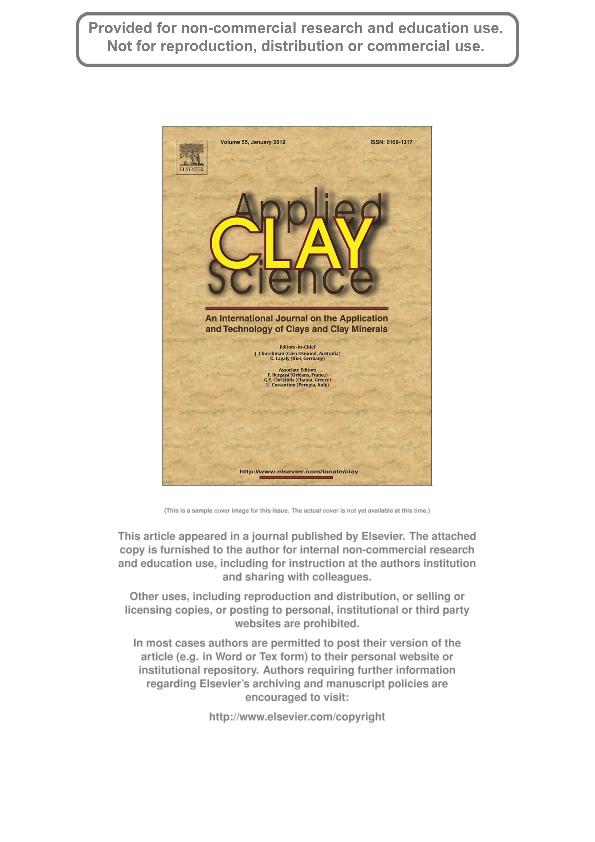Artículo
Mineral assemblages and distribution of phyllosilicates composition along the main section of the Agua Rica deposit, Catamarca, Argentina: Implications for future mine development
Franchini, Marta Beatriz ; Impiccini, Agnes; Beaufort, Daniel; Patrier, Patrice; Anderson, Corby; Pons, María Josefina
; Impiccini, Agnes; Beaufort, Daniel; Patrier, Patrice; Anderson, Corby; Pons, María Josefina
 ; Impiccini, Agnes; Beaufort, Daniel; Patrier, Patrice; Anderson, Corby; Pons, María Josefina
; Impiccini, Agnes; Beaufort, Daniel; Patrier, Patrice; Anderson, Corby; Pons, María Josefina
Fecha de publicación:
10/2012
Editorial:
Elsevier Science
Revista:
Applied Clay Science
ISSN:
0169-1317
e-ISSN:
1872-9053
Idioma:
Inglés
Tipo de recurso:
Artículo publicado
Clasificación temática:
Resumen
Agua Rica (27°26′S–66°16′O) is a world class Cu (Mo–Au) deposit located in Catamarca, Argentina, in which the porphyry and high sulfidation epithermal stages usually distant 1 km vertically, are located at the same level of erosion. Seventy one samples and 120 phyllosilicates were analyzed from the study section (E–W 6969400 N) to determine distinctive mineralogical zones which differ not only by their hydrothermal history but also by their potential behavior during the ore processing operations via flotation. In the east side of the section, biotite K1.78–1.67 Na0.05–0.02(Al0.42–0.00Mg3.77–3.22Fe1.46–1.00Ti0.90–0.18Mn0.02–0.01) (Si5.42–4.82Al3.18–2.58) (OHF1.90–1.40Cl0.06–0.04)4 of the early, high temperature potassic alteration (>550 °C to 370 °C) is encapsulated in a phyllic halo dominated by illite K1.73–1.08 Na0.10–0.0(Al3.96–3.49Mg0.36–0.03Fe0.25–0.01Ti0.06–0.0) (Si6.53–6.07Al1.93–1.47) (OHF0.54–0.0Cl0.02–0.0)4+quartz+pyrite+covellite+molybdenite+rutile. This mineral assemblage formed from fluids with temperatures≤350 °C that attained high sulfur fugacity. The clasts of the hydrothermal and mineralized breccia bodies located at the center of the section and to the east contain widespread pyrophyllite K0.05–0.0(Al4.07–3.94Fe0.12–0.01)(Si7.92–7.50Al0.50–0.05)(OHF0.15–0.02Cl0.03–0.0)4 that had replaced illite at temperatures between 360 °C and 280 °C. Minor amounts of dickite and widespread kaolinite occur in the advanced argillic and phyllic halos, respectively, as late minerals in clots or in veinlets thus, fluids cooled enough (b270° and b200 °C, respectively) for their formation. The presence of phyllosilicate minerals is a potential cause of loss in recovery of copper and molybdenite during the flotation process. Carefully planned and controlled comprehensive liberation and flotation testing should be undertaken in conjunction with mineralogical analysis to optimize and quantify recoveries, separations, grades and gangue deportment.
Archivos asociados
Licencia
Identificadores
Colecciones
Articulos(CCT - PATAGONIA CONFLUENCIA)
Articulos de CTRO.CIENTIFICO TECNOL.CONICET - PATAGONIA CONFLUENCIA
Articulos de CTRO.CIENTIFICO TECNOL.CONICET - PATAGONIA CONFLUENCIA
Citación
Franchini, Marta Beatriz; Impiccini, Agnes; Beaufort, Daniel; Patrier, Patrice; Anderson, Corby; et al.; Mineral assemblages and distribution of phyllosilicates composition along the main section of the Agua Rica deposit, Catamarca, Argentina: Implications for future mine development; Elsevier Science; Applied Clay Science; 67-68; 10-2012; 61-71
Compartir
Altmétricas



